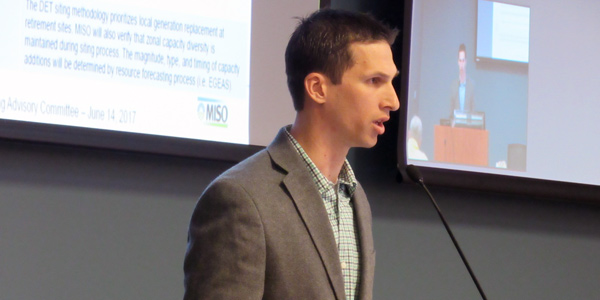By Amanda Durish Cook
Stakeholder sectors have eschewed MISO’s suggestion that they apply equal importance to each of the RTO’s four 15-year future scenarios used for next year’s transmission planning, instead giving more weight to the potential for a slow-and-steady evolution of the generation fleet.
As a result, MISO’s 2018 Transmission Expansion Plan will include a 30% weighting for a continued fleet future, 25% each for limited fleet change and distributed and emerging technologies futures, and 20% for an accelerated fleet change future. The RTO used sector averages and rounded figures to the nearest 5% increment.
Some stakeholders asked why MISO decided to round the averages.
“A percentage here and a percentage there — that doesn’t make a big impact when it comes to project recommendation,” MISO policy studies engineer Matt Ellis said during a Sept. 27 Planning Advisory Committee meeting.
MISO had recommended an equal 25% weighting for all four MTEP 18 futures. Beginning with MTEP 19, equal importance will be assigned to all four grid and generation scenarios, effectively eliminating differential weighting. Staff initially said MISO would abolish weighting beginning with MTEP 18 but changed course in August, explaining that MTEP 18 futures were developed with the understanding that stakeholders would be involved in deciding their importance. (See MISO Delays Removing MTEP Futures Weighting to 2019.)
Minnesota Public Utilities Commission staff member Hwikwon Ham said he supported MISO’s August plan to apply an even 25% likelihood across the board for 2018.
“I share MISO’s concern that we are spending too much time slicing and dicing percentages,” Ham commented, saying that stakeholders were devoting too much time to debating issues that wouldn’t alter project recommendations.
Resource Additions Estimates in MTEP 18
MISO has meanwhile completed a draft projection of future resource additions to inform MTEP 18. The RTO is not projecting much change in resource siting between the MTEP 17 and MTEP 18 futures. However, it created an additional future scenario for the 2018 cycle — the distributed and emerging technologies future — that it predicts will show more than 20 GW of distributed solar in the next 15 years.
Additionally, MISO found that the MTEP 18 futures overall indicate that demand-side and distributed technologies would be spread across more buses in the footprint than in previous cycles.
The futures set out the following scenarios:
- In a limited fleet change future, MISO predicts about 32 GW of generation additions and almost 30 GW of retirements, resulting in coal inching forward to take a 51% share of the resource mix by 2032, compared with today’s 48%. Natural gas generation remains unchanged at 24%, while renewables crawl forward to take a 10% share of generation, up from today’s 8% share.
- In the continued fleet change scenario, the RTO projects more than 54 GW of additions and just about 38 GW of retirements, with a resource mix consisting of 43% coal, 27% natural gas and 15% renewables.
- The accelerated fleet change future yields the most additions at roughly 82 GW, offset by 38 GW of retirements, resulting in 35% coal, 21% natural gas and 30% renewables fleet mix.
- In a distributed and emerging technologies future, generation additions hit 70 GW, while retirements slightly exceed 40 GW, producing a mix of 40% coal, 27% natural gas and 21% renewables.
“There are 45 GW of renewables in the definitive planning phase of the interconnection queue set to come online in the next three years,” Ellis reminded stakeholders. “Now, it’s safe to say that not all of that will come online. I’ll leave that to you to determine. But, if you look at historic trends, roughly 60% of projects make it through the queue.”





